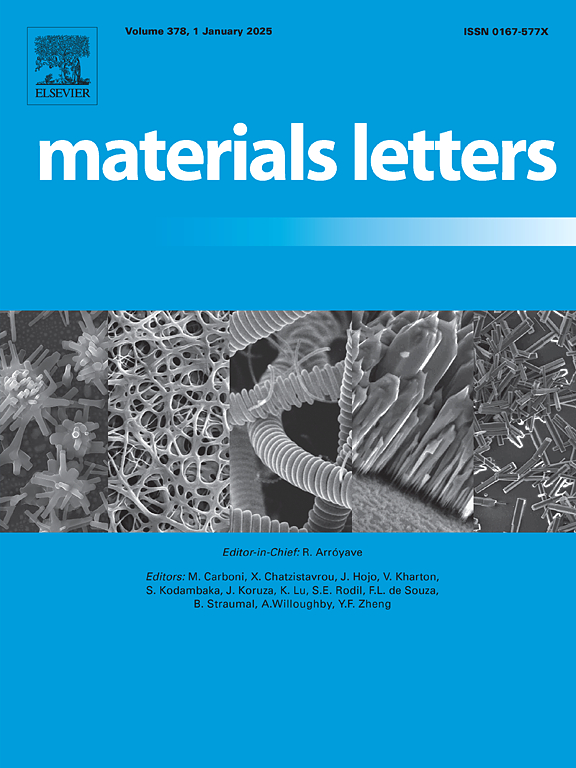Ru-Co双金属界面协同电子调制高效析氢反应
IF 2.7
4区 材料科学
Q3 MATERIALS SCIENCE, MULTIDISCIPLINARY
引用次数: 0
摘要
通过构建Ru3+掺杂co3o4衍生RuCoOx纳米结构,提出了一种异质界面工程策略来增强碱性析氢反应(HER)。结构和电子分析表明,可控的Ru3+掺杂诱导界面电荷重新分配,形成协同的Ru-Co活性位点,提高了本征活性和电子转移动力学。优化后的RuCoOx-2催化剂在10 mA cm -2条件下的过电位为9 mV,在1 M KOH条件下的Tafel斜率为78.1 mV dec - 1,优于大多数钴基基准。值得注意的是,尽管RuCoOx-2只含有4.5 wt%的Ru,但在−1.1 V与RHE作用100小时后,RuCoOx-2仍保持98%的活性。密度泛函理论计算证实,Ru-Co界面协同作用优化了氢吸附自由能(ΔG_H* = - 0.12 eV),降低了水解离障碍,为增强的HER机制提供了原子水平的见解。本文章由计算机程序翻译,如有差异,请以英文原文为准。
Synergistic electronic modulation at Ru-Co bimetallic interfaces for high-efficiency hydrogen evolution reaction
A heterointerface engineering strategy is developed to enhance alkaline hydrogen evolution reaction (HER) by constructing Ru3+-doped Co3O4-derived RuCoOx nanoarchitectures. Structural and electronic analyses reveal that controlled Ru3+ doping induces interfacial charge redistribution, forming synergistic Ru-Co active sites that boost both intrinsic activity and electron transfer kinetics. The optimized RuCoOx-2 catalyst achieves an ultralow overpotential of 9 mV at 10 mA cm−2 and a Tafel slope of 78.1 mV dec−1 in 1 M KOH, outperforming most cobalt-based benchmarks. Remarkably, RuCoOx-2 maintains 98 % activity after 100 h at −1.1 V vs. RHE, despite containing only 4.5 wt% Ru. Density functional theory calculations confirm that Ru-Co interfacial synergy optimizes hydrogen adsorption free energy (ΔG_H* = −0.12 eV) and lowers water dissociation barriers, providing atomic-level insights into the enhanced HER mechanism.
求助全文
通过发布文献求助,成功后即可免费获取论文全文。
去求助
来源期刊

Materials Letters
工程技术-材料科学:综合
CiteScore
5.60
自引率
3.30%
发文量
1948
审稿时长
50 days
期刊介绍:
Materials Letters has an open access mirror journal Materials Letters: X, sharing the same aims and scope, editorial team, submission system and rigorous peer review.
Materials Letters is dedicated to publishing novel, cutting edge reports of broad interest to the materials community. The journal provides a forum for materials scientists and engineers, physicists, and chemists to rapidly communicate on the most important topics in the field of materials.
Contributions include, but are not limited to, a variety of topics such as:
• Materials - Metals and alloys, amorphous solids, ceramics, composites, polymers, semiconductors
• Applications - Structural, opto-electronic, magnetic, medical, MEMS, sensors, smart
• Characterization - Analytical, microscopy, scanning probes, nanoscopic, optical, electrical, magnetic, acoustic, spectroscopic, diffraction
• Novel Materials - Micro and nanostructures (nanowires, nanotubes, nanoparticles), nanocomposites, thin films, superlattices, quantum dots.
• Processing - Crystal growth, thin film processing, sol-gel processing, mechanical processing, assembly, nanocrystalline processing.
• Properties - Mechanical, magnetic, optical, electrical, ferroelectric, thermal, interfacial, transport, thermodynamic
• Synthesis - Quenching, solid state, solidification, solution synthesis, vapor deposition, high pressure, explosive
 求助内容:
求助内容: 应助结果提醒方式:
应助结果提醒方式:


